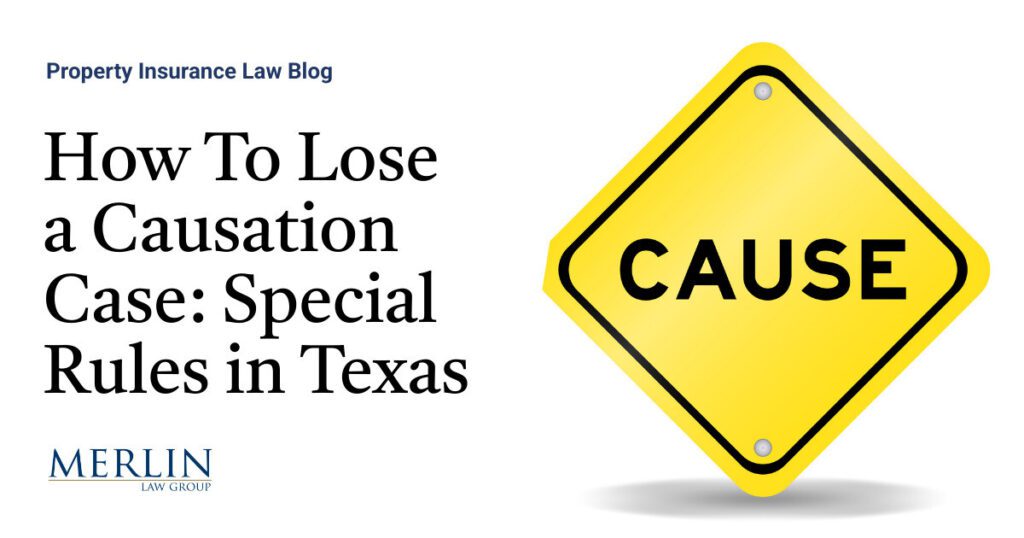How To Lose a Causation Case: Special Rules in Texas

When policyholders file an insurance claim, they expect their insurer to pay losses. Most policyholders have never read their policy nor would appreciate what it even means with nuanced coverage causation rules applying that vary from state to state. A recent case brought to my attention by attorney Steve Badger involving homeowner Ebony Mitchell and Praetorian Insurance Company highlights some key lessons for policyholders, public adjusters, restoration contractors, and attorneys. 1 It’s a cautionary tale of how failing to prove causation can sink a claim and how insurers use the unique Texas view of “concurrent causation doctrine” as a powerful defense.
Ebony Mitchell had homeowner’s insurance with Praetorian and filed a claim after a windstorm damaged her property. Mitchell claimed that Praetorian underpaid the claim. The insurer argued that much of the damage wasn’t from the windstorm but from non-covered causes, including improper roof tarping and bathtub water spillover. When Mitchell pushed back, the company stuck to its position, leading her to file a lawsuit. The case made its way to federal court, where Mitchell lost before the matter even went to a jury.
Mitchell’s biggest problem was proving what part of her damages were actually caused by the windstorm. Texas law is different from other states and requires policyholders to separate covered damages from non-covered ones—essentially placing the burden of proof that portions of loss are covered from those that are excluded. This means that if an insurance company claims some of the damage came from an uncovered source, the burden falls on the policyholder to show otherwise.
This legal concept falls under Texas’ unique view of the concurrent causation doctrine. Nobody else follows it, and I have pointed out that the insurance industry does not teach its adjusters this method of loss adjustment under all risk policies. Not surprisingly, it has become a favorite tool for insurance companies looking to avoid paying claims in Texas. If covered and uncovered damages are mixed together and can’t be separated, the insurer wins by default. No other state in the union has this rule.
To support her claim, Mitchell relied heavily on an estimate called the “Quantum Estimate,” which detailed the costs to repair her property. But there was a problem: the estimate didn’t say who wrote it, and it didn’t explain what caused the damages. The court ruled that without proof of authorship or an expert explaining how the damage was related to the windstorm, the estimate was worthless as evidence.
Even though Mitchell later tried to fix the mistake by submitting an affidavit confirming the estimate’s authenticity, the court wasn’t moved. The judge ruled that even if the estimate was properly authenticated, it still wouldn’t have changed the outcome because it didn’t establish causation. With that, the case was over, and Praetorian’s denial stood.
This case serves as a reminder that proving coverage isn’t just about showing damage—it’s about proving what caused it. Too often, policyholders focus on the cost of repairs without properly documenting the cause. Insurance companies with skilled counsel certainly appreciate that proof counts and use it to their advantage. If a claim goes to court, a Texas insurer can be expected to argue that the policyholder hasn’t met their burden of proof. Without clear, expert-supported evidence linking damages to a covered event, Texas courts, unlike courts in other states, will likely side with the insurer.
Policyholders, their representatives, and even contractors working in the insurance restoration space need to be proactive. They should ensure that their reports include not just repair costs but also a clear and probable explanation of what caused the damage. Policyholders and public adjusters must gather strong documentation that segregates covered damages from excluded ones.
Attorneys should anticipate the Texas concurrent causation defense and be ready with expert testimony that can break it down. The policyholder in this case was represented by the Dick Law Firm. Steve Badger has been keeping a running commentary about this law firm on his LinkedIn messaging. Policyholders should carefully select counsel based on reputation, experience and results rather than pithy advertising with implied reference to one’s genitals.
Some insurance companies aren’t in the business of making payments easy and are looking for ways to prevent paying any more than is required. If you want to win the fight for coverage, you need more than just a showing of damage during the policy period and an estimate if the loss occurs in Texas.
In Texas, you need evidence that holds up under legal scrutiny under this woefully wrong and uniquely applied coverage rule. Otherwise, the insurer will always have the upper hand in causation cases. Texas policyholders who understand this reality and prepare accordingly will stand a much better chance of securing the coverage they rightfully deserve.
For those wanting to study the treatment of causation in Texas, we have written many articles about this. I would suggest State Farm Wins Texas Worn-Out Roof Damage Case: Lesson About Texas Hail Damage Cases, Expert Testimony, and the Very Unique Texas Concurrent Causation Rule, and a post written 14 years ago, Concurrent Causation in Texas. Causation coverage rules can be very complex, and it is especially so in Texas.
Thought For The Day
“Don’t mess with Texas. That includes its barbecue, its beer, and especially its women.”
—Matthew McConaughey
1 Mitchell v. Praetorian Ins. Co., 24-20205 (5th Cir. Mar. 24, 2025). (See also, appellate briefs or Appellant and Appellee).



